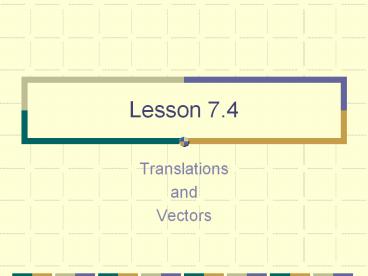Translations - PowerPoint PPT Presentation
1 / 9
Title:
Translations
Description:
Lesson 7.4 Translations and Vectors Lesson 7.4 Define a translation Identify a translation in a plane Use vectors to describe a translation Identify vector notation ... – PowerPoint PPT presentation
Number of Views:53
Avg rating:3.0/5.0
Title: Translations
1
Lesson 7.4
- Translations
- and
- Vectors
2
Lesson 7.4
- Define a translation
- Identify a translation in a plane
- Use vectors to describe a translation
- Identify vector notation
3
Translation Definition
- A translation is a transformation that maps an
object by shifting or sliding the object and all
of its parts in a straight light. - A translation must also move the entire object
the same distance.
4
Theorem 7.4Translation Theorem
- A translation is an isometry.
5
Theorem 7.5Distance of Translation Theorem
- If lines k and m are parallel, then a reflection
in line k followed by a reflection in line m is a
translation. - The segment between P and P is perpendicular to
k and m. - The distance of the translation is twice the
distance between the reflecting lines.
x
2x
6
Coordinate form
- Every translation has a horizontal movement and a
vertical movement. - A translation can be described in coordinate
notation. - (x,y) ? (xa , yb)
- Which tells you to move a units horizontal and b
units vertical.
Q
b units up
P
a units to the right
7
Vectors
- Another way to describe a translation is to use a
vector. - A vector is a quantity that shows both direction
and magnitude, or size. - It is represented by an arrow pointing from
pre-image to image. - The starting point at the pre-image is called the
initial point. - The ending point at the image is called the
terminal point.
8
Component Form of Vectors
- Component form of a vector is a way of combining
the individual movements of a vector into a more
simple form. - ?x , y?
- Naming a vector is the same as naming a ray.
- PQ
Q
y units up
P
x units to the right
9
Use of Vectors
- Adding/subtracting vectors
- Add/subtract x values and then add y values
- ?2 , 6? ?3 , -4?
- ?5 , 2?
- Distributive property of vectors
- Multiply each component by the constant
- 5 ?3 , -4?
- ?15 , -20?
- Length of vector
- Pythagorean Theorem
- x2 y2 length2
- Direction of vector
- Inverse tangent
- tan-1 (y/x)































